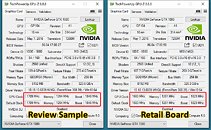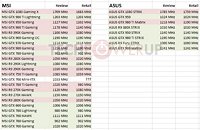- Joined
- Oct 9, 2007
- Messages
- 47,638 (7.44/day)
- Location
- Dublin, Ireland
| System Name | RBMK-1000 |
|---|---|
| Processor | AMD Ryzen 7 5700G |
| Motherboard | Gigabyte B550 AORUS Elite V2 |
| Cooling | DeepCool Gammax L240 V2 |
| Memory | 2x 16GB DDR4-3200 |
| Video Card(s) | Galax RTX 4070 Ti EX |
| Storage | Samsung 990 1TB |
| Display(s) | BenQ 1440p 60 Hz 27-inch |
| Case | Corsair Carbide 100R |
| Audio Device(s) | ASUS SupremeFX S1220A |
| Power Supply | Cooler Master MWE Gold 650W |
| Mouse | ASUS ROG Strix Impact |
| Keyboard | Gamdias Hermes E2 |
| Software | Windows 11 Pro |
MSI and ASUS have been sending us review samples for their graphics cards with higher clock speeds out of the box, than what consumers get out of the box. The cards TechPowerUp has been receiving run at a higher software-defined clock speed profile than what consumers get out of the box. Consumers have access to the higher clock speed profile, too, but only if they install a custom app by the companies, and enable that profile. This, we feel, is not 100% representative of retail cards, and is questionable tactics by the two companies. This BIOS tweaking could also open the door to more elaborate changes like a quieter fan profile or different power management.
MSI's factory-overclocked GeForce GTX 1080 Gaming X graphics card comes with three software-defined clock-speed profiles, beginning with the "Gaming Mode," which is what the card runs at, out of the box, the faster "OC mode," and the slower "Silent mode," which runs the card at reference clock speeds. To select between the modes, you're expected to install the MSI Gaming software from the driver DVD, and use that software to apply clock speeds of your desired mode. Turns out, that while the retail cards (the cards you find in the stores) run in "Gaming mode" out of the box, the review samples MSI has been sending out, run at "OC mode" out of the box. If the OC mode is how the card is intended to be used, then why make OC mode the default for reviewers only, and not your own customers?

Above, you see two GPU-Z screenshots, one of the TPU review sample, next to the retail board (provided by Nizzen). Flashing the retail BIOS onto our review sample changed the clocks to match exactly what is shown on the GPU-Z retail screenshot.
In case of the GTX 1080 Gaming X, the "Gaming mode" runs the card at 1683 MHz core and 1822 MHz GPU Boost; and the "OC mode" runs it at 1708 MHz core and 1847 MHz GPU Boost. The cards consumers buy will run in the "Gaming mode" out of the box, which presumably is the default factory-overclock of these cards, since they're branded under the "Gaming series."

The "OC Mode" is just there so consumers can overclock it a little further at the push of a button, without having any knowledge of overclocking. Now if the OC mode is enabled for review samples of one company and not for the others, this means that potential customers comparing reviews will think one card performs better than the other, even if it's just 1%, people do base their buying decision on such small differences.
With the case of the GTX 1080 at hand, we started looking back at our previous reviews and were shocked to realize that this practice has been going on for years in MSI's case. It looks like ASUS has just adopted it, probably because their competitor does it, too, "so it must be ok."

It's also interesting to see that not all cards are affected, whether this is elaborate or by accident is unknown.
While we don't have any statements of the companies yet, the most likely explanation is that reviewers usually don't install any software bundled with the graphics card, yet the companies want the cards to be tested in OC mode, which provides higher performance numbers, beating their competitors. That's probably how this whole thing started, nobody noticed and the practice became standard for reviews moving forward.
This issue could affect upcoming custom GeForce GTX 1070 review samples too, we will be on the lookout.
View at TechPowerUp Main Site
MSI's factory-overclocked GeForce GTX 1080 Gaming X graphics card comes with three software-defined clock-speed profiles, beginning with the "Gaming Mode," which is what the card runs at, out of the box, the faster "OC mode," and the slower "Silent mode," which runs the card at reference clock speeds. To select between the modes, you're expected to install the MSI Gaming software from the driver DVD, and use that software to apply clock speeds of your desired mode. Turns out, that while the retail cards (the cards you find in the stores) run in "Gaming mode" out of the box, the review samples MSI has been sending out, run at "OC mode" out of the box. If the OC mode is how the card is intended to be used, then why make OC mode the default for reviewers only, and not your own customers?

Above, you see two GPU-Z screenshots, one of the TPU review sample, next to the retail board (provided by Nizzen). Flashing the retail BIOS onto our review sample changed the clocks to match exactly what is shown on the GPU-Z retail screenshot.
In case of the GTX 1080 Gaming X, the "Gaming mode" runs the card at 1683 MHz core and 1822 MHz GPU Boost; and the "OC mode" runs it at 1708 MHz core and 1847 MHz GPU Boost. The cards consumers buy will run in the "Gaming mode" out of the box, which presumably is the default factory-overclock of these cards, since they're branded under the "Gaming series."

The "OC Mode" is just there so consumers can overclock it a little further at the push of a button, without having any knowledge of overclocking. Now if the OC mode is enabled for review samples of one company and not for the others, this means that potential customers comparing reviews will think one card performs better than the other, even if it's just 1%, people do base their buying decision on such small differences.
With the case of the GTX 1080 at hand, we started looking back at our previous reviews and were shocked to realize that this practice has been going on for years in MSI's case. It looks like ASUS has just adopted it, probably because their competitor does it, too, "so it must be ok."

It's also interesting to see that not all cards are affected, whether this is elaborate or by accident is unknown.
While we don't have any statements of the companies yet, the most likely explanation is that reviewers usually don't install any software bundled with the graphics card, yet the companies want the cards to be tested in OC mode, which provides higher performance numbers, beating their competitors. That's probably how this whole thing started, nobody noticed and the practice became standard for reviews moving forward.
This issue could affect upcoming custom GeForce GTX 1070 review samples too, we will be on the lookout.
View at TechPowerUp Main Site
Last edited by a moderator:






